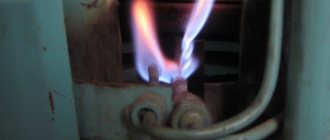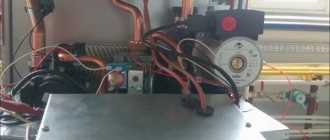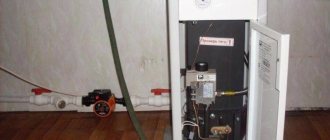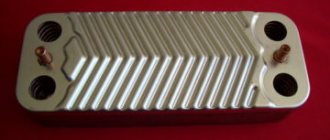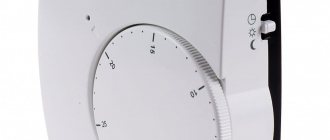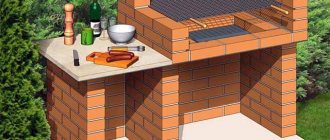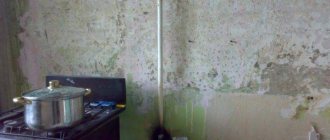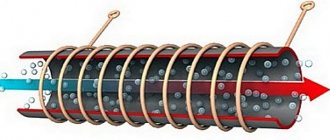It is very unpleasant when, in the middle of winter, some problems begin with heating equipment in a private home, for example, with a gas boiler. According to Murphy's law, the heat source begins to mope on the coldest days, when its shutdown leads to a rapid cooling of the coolant in the system, and after it, the entire building.
The first thing that comes to mind is to call a specialist who will solve your problem. The idea is correct, but due to many reasons, the arrival of a specialist may be delayed for several hours, or even days. Instead of slowly freezing, try to find out the reason why the gas boiler goes out and fix the problem yourself. We will tell you what to do in such a situation.
Why does the gas boiler burner go out?
The answer is simple - the fuel supply is shut off by reliable automation installed on all heating units using natural or liquefied gas. The burner will turn off and the gas boiler will go out in any of three cases:
- the draft in the chimney has decreased or disappeared;
- the gas pressure in the supply line has dropped below normal;
- the flame of the burner itself went out.
For reference. Gas valves from the Italian EuroSIT or the American brand Honeywell act as automatic shut-off devices.
The automation can work either due to external factors or due to the breakdown of any part of the heat generator. In this regard, it is easier to deal with non-volatile floor-standing boilers of simple design, since there is literally nothing to break in them, and the burner more often goes out due to external reasons than from malfunctions. These include the brands Danko, Zhitomir, Aton, Ross and other manufacturers of gas-using devices from the countries of the former USSR.
Gas valve EuroSit (right) and Honeywell (left)
A more modern wall-mounted electric gas boiler, equipped with a closed combustion chamber, is a miniature boiler room equipped with additional protection stages that shut off the fuel supply in the following situations:
- the movement of coolant in the heating system has stopped (the flow sensor is triggered);
- the air supply has decreased or stopped, as indicated by the pressure switch (another sensor);
- power surges occur in the home electrical network;
- during a power outage.
Note. At the moment, only one Russian manufacturer offers high-quality wall-mounted boilers - Neva; the rest of the market is occupied by imported brands from Europe and Korea.
Types of household heating units that burn natural gas
When a wall-mounted heat generator begins to go out, it is not easy to fix it, but a number of malfunctions can still be eliminated with your own hands. How to do this correctly - read on.
Main characteristics
If you want to purchase this equipment, then you need to know which parameters play the main role.
- Flame type. The flame may resemble a torch or be a swirl type. For spot soldering, a flame in the form of a torch is suitable. This will allow you to influence a small area of the product. But the vortex flame warms up a large surface area well.
- Flame adjustment. Some types of burners do not have a regulator at all. On the rest it is located in different places. The simpler the fire adjustment, the more convenient the work. The variety of positions of the regulator will allow you to process different materials and perform other operations in addition to soldering - metal tempering, heating and others.
Devices with disposable and stationary cylinders
The most convenient and compact device is a mini-gas burner, which is equipped with a disposable cylinder. It is good to use for soldering copper products in hard-to-reach places, and its low weight and compactness make the work more convenient. The fuel in such burners is gas mixtures, acetylene or propane. On the handle of the device there is a valve for adjusting the fire level.
Maximum connection quality can be achieved by using gas burners with stationary cylinders. With their help, you can process even the most refractory metals.
Damping of boilers with an open combustion chamber
By default, we consider a situation where the heating unit has worked for several seasons without complaints, and now for some reason it has begun to go out. An extended list of reasons that cause an automatic valve to stop supplying gas looks like this:
- the draft in the chimney disappeared;
- there were problems with the supply of natural gas, causing its pressure in the pipe to drop below normal;
- the boiler does not have enough combustion air, causing the flame to go out;
- the burner is blown out by a strong wind outside or the flame breaks off due to a strong draft inside the house;
- hardware malfunctions of the gas boiler - failure of the draft sensor or thermocouple.
Lyrical digression. Home owners may not immediately notice the attenuation of the gas burner device, especially when the unit is installed in a separate room. The problem is discovered when the air temperature in a private house has already dropped.
The boiler burner has gone out - the radiators have cooled down.
So, if your main boiler burner goes out, then look for the reason in the specified sequence, starting with checking the draft in the chimney. Let's look at each step in detail.
Traction problems
The first thing that owners of atmospheric gas boilers should do when the burner goes out is to check the draft. Take matches or a candle, light it and bring it to the viewing window and observe the behavior of the flame. If it deviates towards the opening, then everything is in order with the thrust and you can move on to the next step.
If the flame does not deviate, then there is no draft in the chimney
The fire remained motionless; the cause of the burner extinguishing was discovered; the draft in the chimney disappeared. Your actions:
- Open the window to the boiler room slightly so that air flow is guaranteed into the room.
- Disconnect the section of the chimney connected to the outlet pipe of the heating unit, and then check the presence of draft in the chimney pipe itself. If there is one, you need to disassemble and clean the gas boiler itself, which is discussed in a separate article.
- If no draft is detected in the main channel, then it is probably clogged. Find the hatch for maintenance and cleaning; it is located in the boiler room below the connection point or on the street. Open the hatch and insert the mirror inside to see the exit hole. If it is not visible, then the chimney must be cleaned.
- Inspect the outside of the pipe head; a bird's nest may have appeared there during the summer. Another option is complete freezing of the cap covering the cut of the chimney. This happens during severe frosts, when ice blocks the working section of the chimney.
Iced chimneys with caps
Important! The operating rules for gas-using installations directly prohibit placing umbrellas on top of chimney pipes. If you have such a cap, it must be dismantled. Only open tapered nozzles may be used.
Briefly about the reasons for clogged smoke ducts:
- uninsulated brick walls are destroyed by condensation, causing the flow area to become clogged with construction debris;
- in cheap sandwich chimneys, the zinc coating can peel off from the inner wall and block the channel in the form of a thin film;
- 2 boilers are connected to one chimney - gas and solid fuel, so it is clogged with soot;
- Foreign objects from the activity of birds may get into the pipe.
There is not only a lot of soot in the chimney pipe, but also birds.
Cleaning the chimney may not produce results when its walls freeze through at low temperatures outside. The fact is that the combustion products of gas heat generators have a relatively low temperature (up to 120 ° C) and are unable to warm up the chimney so that a stable draft occurs. Since you won’t be doing insulation in the middle of winter, there is only one way out - buy a disposable torch with a can, light it and stick it into the open cleaning hatch. When the frozen channel warms up, start the boiler, but do not turn it off for a long time, otherwise the procedure will have to be repeated.
Food for thought. There are situations when a two or three-story cottage is being built on a neighboring site in close proximity to your home. As a result, the chimney may enter the leeward zone of a neighboring building, and this leads to a decrease in draft, as a result of which the gas boiler goes out. Since you cannot prohibit your neighbors from building, you will have to increase the chimney by 1-2 m in order to remove it from the stagnant zone.
Other reasons for deterioration of draft in the chimney and blowing by the wind (from left to right): low position of the pipe cut, obstacles in the form of trees and downward air flow. The
simplest and cheapest way to combat wind blowing into a problem chimney is to install a damper at the outlet of the gas boiler. True, if weather conditions change, its position will have to be adjusted, because with a half-blocked channel cross-section, the heater will not reach the optimal operating mode, and fumes may enter the house. Therefore, the best way to overcome draft overturning is to increase the chimney by 1-2 m.
Reduced gas pressure in the line
After making sure that there is draft in the chimney, proceed to the next step - checking the fuel supply. A sign of low gas pressure at the inlet is the burner going out for no apparent reason, and the flame on the boiler igniter continues to burn. What can be done:
- Check how well the gas flows from the pipeline. First, close the door to the boiler room, open the window and unscrew the supply hose from the heat generator pipe. Briefly open the gas valve. A sign of a good delivery is a loud hiss from the hose and a strong smell of odorized methane. Reinstall the hose and check the tightness of the joint with soapy water.
- If the fuel supply is poor, clean the gas strainer and then try to light the wick and the main burner of the boiler. If the result is negative, call the appropriate service and call a gas technician.
Attention! Before performing any manipulations with the fuel pipeline, be sure to turn off the gas shut-off valve!
On the way to your heating unit, the line may become clogged in one more place - inside the gas meter. This happens after repairing external pipelines, when rust or scale from welding gets into them. But it is prohibited to disassemble the meter for cleaning; only calling a specialist will help.
Meter and filter on the gas supply pipeline
At the beginning of the heating season, when heating equipment is turned on en masse in private homes, the fuel supplier is obliged to monitor the pressure in the line and increase the volume of gas supplied. Sometimes the service response is delayed, as a result of which consumers located at a network dead end may not have enough fuel. There is nothing you can do here except make an angry call to the supplier company or start a second boiler using electricity or wood (if you have one).
Lack and excess of air
Any of these phenomena leads to the fact that the gas boiler may periodically go out. For its normal operation, supply air must enter the furnace room through the ventilation duct or from other rooms. At the same time, strong drafts that could blow out a burner operating in low power mode should not be allowed.
It is easy to verify the lack of oxygen: open the nearest window and observe the behavior of the flame. If the burner operation has stabilized, then the reason for the attenuation is clear. Let's figure out why this happens:
- you have installed sealed plastic windows and the air flow inside the house has stopped;
- one or more interior doors were replaced and the gaps between the doors and the floor, where air previously passed, were greatly reduced;
- you installed a powerful kitchen hood that draws part of the air flow towards you;
- the same effect is observed when installing forced exhaust hoods in the toilet and bathroom.
Scheme of operation of an atmospheric burner
When buying various exhaust devices, remember that the removed air must be compensated for by the influx, otherwise the draft in the chimney will decrease, or even tip over in the opposite direction. Then the question will arise - what to do when the gas boiler is blown out by the wind. Special supply valves must be installed on plastic windows, and to compensate for the forced exhaust, it is necessary to organize a mechanical inflow from the street.
Advice. Purchasing and installing an air handling unit is not a cheap pleasure. A compromise could be to organize a natural flow into rooms with excess heat (for example, into the kitchen or directly into the boiler room), where the outside air has time to heat up.
A separate story is parapet gas boilers and convectors with a short coaxial chimney that goes out directly through the wall. Since combustion products move through them naturally, if the smoke outlet is unfavorably located, the burner is often blown out by the wind. The problem is solved this way: determine the direction of the draft in the yard and tightly close the protective grille on the windward side.
What to do when the wind blows into a coaxial chimney
Atmospheric boiler malfunctions
Non-volatile floor heat generators have several elements that cause trouble over the years of operation. Signs of their breakdown are as follows:
- When you try to light the igniter, it goes out immediately after releasing the button on the valve. This means that the thermocouple, which heats up from the wick and maintains the gas supply solenoid valve in the open state, has become unusable.
- The floor-standing gas boiler does not ignite at all, not even the pilot burner. This indicates unreliable contact in the electrical circuit connecting the automation unit to the traction sensor. The element itself rarely fails.
- When the main burner ignites with difficulty, operates intermittently and pops, and the color of the flame is yellow, then the main fuel jet is clogged.
Thermocouple (left) and draft sensors from different manufacturers
The thermocouple is a copper tube with a bimetallic element at one end. From the second side comes a capillary connected to the gas valve. The junction of dissimilar metals is washed by the flame of the igniter, due to which a voltage of 20-50 millivolts is generated, which keeps the valve solenoid open. The thermocouple cannot be repaired, only replaced.
Briefly about the principle of operation. When igniting, we open the valve manually; after heating from the wick, it is held by a thermocouple. A traction sensor is connected in series with the electromagnet, breaking the circuit in case of overheating from gases accumulated in the smoke collector.
The draft sensor is a tablet-shaped part located at the outlet of combustion products and connected to the gas valve with two wires. It’s easy to check the functionality - close the contacts where these wires are connected and try to ignite the burner; if successful, replace the sensor with a new one. Since it supplies a negligible voltage, the cause of the malfunction is sometimes the old connecting wires, which create high resistance. The issue can be resolved by replacing them or cleaning all contacts.
The thermocouple is mounted on the same flange with the igniter and is washed by its flame
We do not recommend removing the gas burner device of the boiler with your own hands to clean the nozzle. But if there is no other way out, then do not forget to turn off the gas before starting work, and only then unscrew the fasteners. Try not to disassemble unnecessary joints of the gas line, and after assembly, check them for leaks with a soap solution.
Addition. The burner of the floor heating unit will not start when the circulation pump installed outside the boiler fails. It will heat the water in the boiler tank, and then turn off until this coolant cools down.
What does it depend on?
The burner temperature is determined by the chemical composition of the gas and the power of the product. During the research, it was possible to establish that the temperature parameters of the torch depend on the calorific properties of the gas mixture.
After combining the fuel with air, the gas is consumed critically, so the combustion intensity increases. By using an additional air source, you can increase the temperature you get at the burner. Without blowing, the value reaches 1500 degrees; access to auxiliary air flow gives an increase of up to 2200 degrees. The temperature differs in different parts of the torch :
- Internal . This is a short zone with little heating.
- Average . In this area, the temperature of the flame from the gas burner reaches its limit, but the fire does not open completely, which is due to a lack of oxygen and the release of decay products.
- Bordering . Visually characterized by a bright fire with high efficiency.
Cheap burner models are structurally the same. Expensive ones are equipped with additional elements that increase technical characteristics and ease of use.
To perform welding and cutting, special requirements are placed on the composition of the gas mixture, since the temperature regime of the product depends on it.
Repair of wall-mounted and turbocharged units
Wall-mounted gas boilers with open and closed combustion chambers are more complex devices equipped with modern electronics and safety elements. But here, too, some problems can be solved on your own. All the manipulations described above with checking traction, fuel supply and sensors are just as relevant for wall-mounted atmospheric heat generators.
To find faults in a wall-mounted electric gas boiler, you need to arm yourself with the product’s operating instructions and a Phillips screwdriver; you are unlikely to need other tools. The technical data sheet contains the fault codes displayed on the heater display, and a screwdriver is needed to remove the front panel.
There are 3 non-working states of the heat generator:
- The boiler is completely turned off, not a single indicator lights up.
- The unit is turned on, the display and power indicator are on, but automatic ignition does not occur.
- There are attempts to start the main burner, but after ignition it immediately goes out.
Advice. In the event of a complete failure of a wall-mounted boiler connected to the house electrical network, always check whether voltage is supplied to it. The cause of the problem may be a tripped circuit breaker located in the switchboard. Point two: almost all imported units are sensitive to the location of the phase and the issue is often resolved by switching the plug in the socket so that the contacts are swapped.
The fuse box is located on the electronic board of the boiler.
Having made sure that voltage is supplied to the heater, we can begin to repair condition No. 1. To do this, unscrew the front panel of the gas boiler with a screwdriver or an asterisk wrench and remove it or fold down the front cover (depending on the model). Then the algorithm is as follows:
- Locate the fuse box and check each one with a multimeter or visually. Surely there will be one that is burned out.
- As a rule, the spare fuse is glued to the inside of the front panel. Put it in place of the burnt one or buy a new one (exactly the same value!).
- Try starting the heating unit. If it works, then the repair is complete, put the cover back in place.
- Did the device turn on and “die” again? All that remains is to call a technician, since the problem is more serious.
Advice. After opening the panel, carefully inspect all elements of the heat generator for leaking joints, broken or fallen wires, and burnt parts on the board. If you find the latter, immediately call a specialist. Our expert Vladimir Sukhorukov will tell you more about the troubleshooting algorithm for a wall-mounted gas boiler in his video:
In the other two non-working states, the display shows an error code, by which you can determine the problem by looking at the product data sheet. The expert recommends the following: when the documentation says “contact service” next to the error code, then that’s what you need to do; you won’t be able to handle the breakdown yourself. You can resolve the following errors yourself:
- The sump filter that filters the coolant from the heating system is clogged. Disconnect the heat generator from the house electrical network, turn off the taps and clean the element mesh.
- The built-in circulation pump does not work. The reasons are jammed rotor or air lock. In both cases, unscrew the large screw (located in the center of the pump) and release the air or turn the rotor with a screwdriver. Be careful, some water will flow out of the hole.
- When the boiler pressure gauge shows low pressure and there are no leaks in the heating system, you need to pump air into the expansion tank mounted inside the heating unit. The pressure on the air side of the membrane should be 0.2 bar less than in the system. Read more about pumping up the tank here.
- If a leak is detected at low pressure, it must be repaired and then added to the water system.
Note. The display will not show an error in a situation where the electrical circuit of the room thermostat or the gas boiler’s own thermostat is broken. More information in the second part of the video from our expert:
What gas is used in cylinders
Almost all cylinders contain a mixture of propane with butane or isobutane in different proportions. An important selection criterion is the amount of propane:
- The vast majority of cylinders contain 20-30 percent propane. Such products are quite suitable for use with burners, however, when the temperature drops to -15 degrees, the gas simply will not burn.
- 50 percent. With such a propane content, the cylinder can easily be used in winter, withstanding temperatures down to minus 30. This is confirmed by the snowflake on the surface of the product.
- 100 percent. Coleman produces pure propane in cylinders. The gas burns well at temperatures down to -42 degrees Celsius. In this case, thick-walled cylinders are used, which prevents their destruction in severe frost.
Propane is not used at all in the products of domestic companies. Such cylinders contain 100 percent butane, isobutane or a mixture of these gases. The products work great in the summer, but fail even at minus 5 degrees.
When choosing between butane and isobutane, try to buy the second option. It burns more stably, which is explained by the high octane number and uniform composition. How long does a bottle last? The answer to this question depends on several important factors:
- Terms of Use. During the cold period, the cylinder stops working much faster than in summer.
- Volume. If you give exact figures, then a 500 gram can can burn for about two days.
- Intensity of use. The continuous burning time of a 0.5 liter cylinder is 5-6 hours. But if you only cook food 3-4 times a day, you will get the 2 days mentioned above.
Almost any canister (except a pierceable one) can be recharged. How to do it? It is best to contact specialized companies, since refueling yourself can lead to unpredictable consequences. After recharging, do not risk taking the product on a camping trip. It is suitable for household purposes only.
Adjustment
The cleanliness of the cut depends on the correct flame setting . Oxygen treatment is carried out with a slightly oxidized or normal torch. The carefully adjusted flame of cutters with concentric nozzles is surrounded by a cutting stream of oxygen. The core of the torch in each section should be symmetrical and not differ in brightness.
Cutting with a torch with the mouthpiece moved cannot be carried out, as this will lead to heating of the edge, which will negatively affect the quality of the cut. The use of self-centering mouthpieces increases the ease of use of such equipment, because the device makes the flame symmetrical.
Sometimes the movement of the gas mixture is hampered due to clogging of the channel, which divides the torch into streams and leads to loss of stability. Such a product not only reduces the quality of processing, but also reduces productivity. Flame adjustment is based on creating a symmetrical flame of the required power in relation to the oxygen cutting jet.
A normal flame is ensured with the valves slightly open, which makes it possible to make adjustments during operation. When acetylene and oxygen are fully open, an excessive amount of the former is observed. Smooth closing of the acetylene valve leads to stabilization of the process.
Temperature conditions of different types of burners per cylinder
You can purchase a burner online or at a hardware store. It is better to give preference to the second option, since the buyer can consult with an experienced seller, he will select the appropriate option depending on the tasks set by the user. The product range includes models that differ in temperature conditions:
- Refillable. They are characterized by small dimensions and thoughtful shape, as well as ease of use and a piezoelectric element. This type does not apply to the cylinder variety of gas burners.
- On a collet can. They are a source of powerful flame with an average outlet temperature of 1500 degrees.
- Threaded. Propane accounts for the lion's share of the fuel, due to which the temperature in the combustion zone is 1800 degrees. Advanced models are equipped with systems for mixing air with a propane mixture.
Some burners are equipped with autonomous heating of the combustible mixture, which increases the angle of use.
